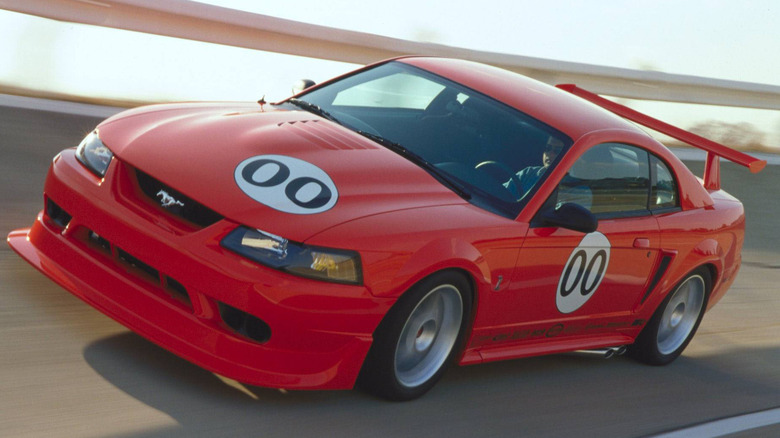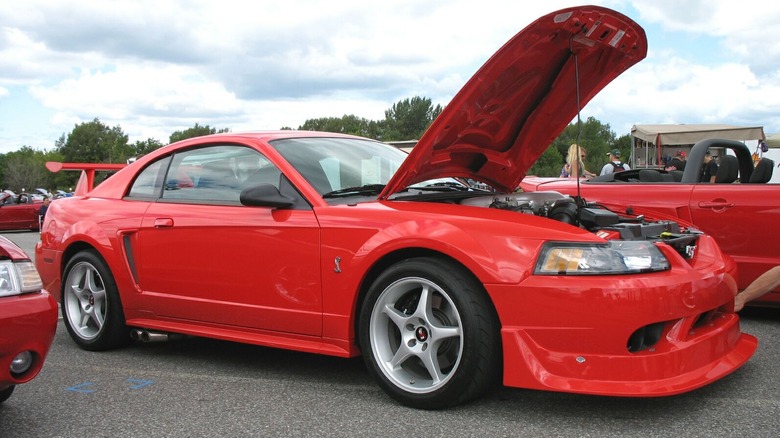Here's What Made The 2000 SVT Mustang Cobra R Engine So Great
In the early 1990s, Ford assembled its Special Vehicle Team to "create vehicles to satisfy the unique desires of the knowledgeable driving enthusiast," which led to the 1993 Mustang Cobra and Mustang Cobra R. The Mustang Cobra went on to make regular appearances in the pony car lineup, but the Cobra R — short for race-ready — was only offered a few years, the last being 2000.
At the time, the 2000 SVT Mustang Cobra R was the fastest factory-produced Mustang ever, primarily because of its 5.4-liter dual overhead cam V8 engine, which was a sizable jump in displacement over the regular Mustang GT's 4.6-liter V8. Besides a cubic-inch advantage, the Cobra R's 5.4L had a custom intake manifold mounted to a set of cylinder heads that flowed 25% more air than the prior year's Mustang Cobra.
Because of the engine's height, SVT engineers needed custom motor mounts and a unique crossmember to lower the engine 12 millimeters so that it would fit under the Mustang's hood. Though the hood already had a prominent bump in the center to accommodate the larger engine, it wasn't enough.
The exhaust system was also bespoke for the Cobra R, a stainless steel affair by muffler magnate Borla that exited out the sides of the car in front of the rear wheels. The reason for the unconventional side exit was a larger-than-stock 21-gallon fuel cell in the rear of the vehicle that precluded the exhaust system from exiting at its usual location.
A dyno test proved that Ford underrated the engine
The result was 385 horsepower and 385 lb-ft of torque at the crankshaft for the Cobra R versus 260 horsepower and 302 lb-ft for the original. Like other SVT vehicles, Mustang enthusiasts felt Ford underrated the Cobra R's engine — confirmed when Late Model Restoration dyno tested a customer's car.
Stock except for an aftermarket exhaust, the Cobra R made approximately 390 horsepower and 388 lb-ft of torque at the rear wheels, which translates into well over 400 horsepower at the crankshaft because of the parasitic drag of the drivetrain once an engine is installed in a vehicle.
Since the Cobra R was basically a street-legal race car, anything not vital to performance was omitted. That includes air conditioning, a stereo system, sound-deadening material, and even the back seat. Although it's fast in a straight line — zero to 60 took only 4.4 seconds — the twisty bits are where the Cobra R excels, pulling 1.01 units of g-force on the skidpad courtesy of its Bilstein shock absorbers, Eibach springs, and beefy inch-thick sway bars.
Ford only made 300 of the 2000 Mustang Cobra R, all painted Performance Red Clearcoat with a ground effects kit and massive rear wing. The only available transmission was a T-56 manual with six speeds — a first in any Mustang. The car was priced at $54,995 (approximately $99,000 today), but rumors of the final edition Cobra R being bid up more than MSRP when new are rampant.
[Featured image by CJ DUB via Wikimedia Commons | Cropped and scaled | Attribution (BY)]

